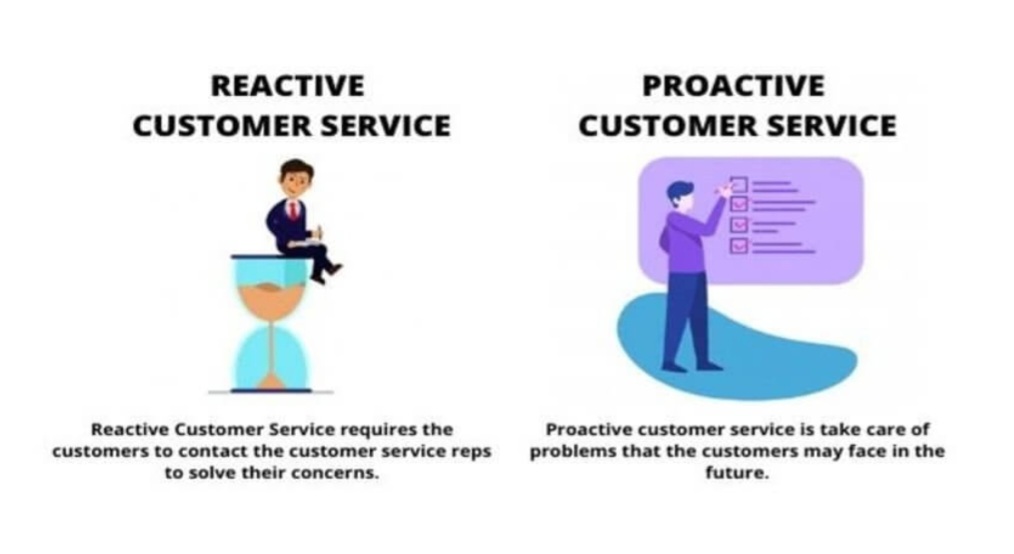
Why Proactivity is Essential:
A proactive customer strategy enables companies to anticipate and address potential challenges before they impact the customer experience. By regularly gathering customer feedback, analyzing market trends, and forecasting future needs, companies can create value at every touchpoint. This builds a loyal customer base, ensures steady revenue growth, and establishes the brand as a market leader.
1. Anticipating Customer Needs: By understanding your customers’ preferences, pain points, and goals, you can anticipate what they might need even before they realize it themselves. This could mean offering product recommendations based on past purchases, rolling out features in response to emerging trends, or creating support resources that address common questions. A proactive approach helps create smoother customer experiences and keeps them engaged.
2. Building Trust and Loyalty: When customers see that a company understands and even predicts their needs, they’re more likely to trust and remain loyal to that brand. Proactive companies show they care about their customers’ success, making them more likely to continue doing business with that brand and even refer others.
3. Reducing Customer Churn: A reactive approach often involves addressing customer issues after they’ve escalated, which can lead to frustration and, ultimately, churn. Proactive strategies, such as regularly checking in with customers, monitoring feedback, and offering solutions before problems occur, can reduce churn significantly. Customers are more likely to stay if they feel valued and supported.
4. Enabling Predictable Growth: Proactive customer strategy contributes to more stable and predictable growth. By staying ahead of customer expectations, companies can plan better and allocate resources to areas that matter most, resulting in consistent performance and long-term growth.
5. Creating a Differentiated Experience: In today’s competitive market, customer expectations are higher than ever. Companies that are proactive in enhancing customer experience can set themselves apart from competitors. Proactively improving user experiences, providing seamless interactions, and offering added value demonstrate a commitment that goes beyond simply selling a product or service.
Examples of Proactive Customer Strategy in Action
1. Regular Check-Ins: Companies that reach out to customers periodically to see how things are going or offer help before it’s asked are practicing proactive strategy. For example, a software provider might check in quarterly to ensure customers are maximizing the tool’s features or to address any usage questions.
2. Predictive Analytics and Customer Data: Proactive companies use data and analytics to predict customer needs and preferences. For instance, an online retailer may analyze purchase patterns to recommend products or send reminders when it’s time to reorder consumables. This not only boosts sales but also shows that the company is in tune with the customer’s buying cycle.
3. Proactive Support Channels: Offering resources like self-service portals, FAQs, or even AI-driven chatbots that answer common questions allows customers to get help without waiting for an issue to become a problem. For example, a financial services company might offer proactive education on tax-saving strategies or retirement planning based on customer profiles.
Shifting from Reactive to Proactive
When a company takes a reactive rather than proactive approach to customer strategy, it often finds itself playing catch-up, which can lead to serious consequences. Here’s a breakdown of what typically happens and why being proactive is essential:
1. Customer Loss to Competitors
Why it Happens: When a business waits until problems surface—such as customer complaints, dissatisfaction, or negative feedback—it signals to customers that their needs and experiences are secondary. Competitors who proactively address customer needs and anticipate issues are seen as more attentive and aligned with what customers expect.
The Consequence: Customers who feel undervalued or frustrated with slow responses are more likely to switch to competitors offering a better experience. In today’s market, switching is easy, and customers are informed; they will quickly find alternatives.
2. Revenue Decline and Market Share Loss
Why it Happens: By the time a business reacts to declining sales or a shrinking customer base, it’s often already too late to recover lost ground. Reactive strategies tend to focus on temporary solutions, like discounting or urgent promotions, which may bring short-term revenue but do not build lasting relationships or address root causes.
The Consequence: Reactive tactics can erode brand value, as customers may view the brand as inconsistent or desperate. This approach does not foster loyalty or long-term growth, making it harder to maintain a stable revenue stream and ultimately resulting in market share loss.
3. Increased Costs and Strain on Resources
Why it Happens: Reactive approaches can lead to crisis-mode spending—investing in customer retention programs or product fixes only after issues have escalated. The need to hire more customer service staff or roll out urgent changes drains resources that could have been allocated more efficiently.
The Consequence: This approach places additional strain on teams and budgets, often requiring expensive, last-minute changes. This reactive approach not only affects profit margins but also impacts team morale, as employees constantly scramble to address issues instead of focusing on growth and innovation.
4. Difficulty in Rebuilding Trust and Loyalty
Why it Happens: Customers value companies that demonstrate reliability and consistency. When a company continually reacts to problems rather than preventing them, it gives the impression of instability, eroding trust.
The Consequence: Rebuilding trust is far harder than building it initially. Customers may perceive the brand as unreliable or inattentive, making them less likely to recommend the company or return after a bad experience.
5. Loss of Competitive Edge and Innovation Opportunities
Why it Happens: Proactive companies keep a finger on the pulse of customer preferences, market trends, and technology advances. They anticipate needs and innovate early, setting them apart from slower competitors.
The Consequence: A reactive company misses opportunities to innovate and enhance its product line or service delivery. Competitors who stay ahead will capture forward-thinking customers, making it difficult to regain relevance or stand out in a competitive landscape.
Proactivity is Essential:
Transitioning from a reactive to a proactive approach can involve a few changes:
Continuous Monitoring: Regularly track customer behavior, feedback, and trends so you can spot emerging issues and address them early.
Customer Journey Mapping: Understand the complete customer journey to identify potential roadblocks or opportunities where you can engage customers before they experience friction.
Employee Empowerment: Equip employees with tools, training, and authority to anticipate customer needs and provide solutions without having to wait for management’s input.
Feedback Loops: Constantly seek feedback from all departments, allowing for quick pivots and refinements to strategy based on what customers are saying and feeling in real time.
Conclusion
Being proactive in customer strategy means going beyond mere problem-solving to create a proactive, relationship-focused approach. In doing so, companies can foster trust, loyalty, and long-term success. By anticipating customer needs and consistently enhancing their experience, companies position themselves as true partners in their customers’ success rather than merely providers of products or services.
https://www.linkedin.com/in/anthonycrilly





Companies that stay ahead avoid ‘Tempt-the-Moan’ syndrome by being proactive. Set up regular customer check-ins, use data to predict needs, and empower teams with simple tools for fast response. A few minutes spent on preparation today saves hours on firefighting tomorrow. Get ahead, and keep customers happy before they even have a reason to complain.
This keeps messaging direct and focused, which is perfect for busy professionals with limited bandwidth.